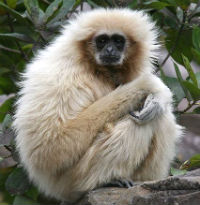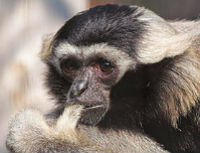White-handed × Pileated Gibbon
Hylobates lar × Hylobates pileatus
Mammalian Hybrids
EUGENE M. MCCARTHY, PHD GENETICS, ΦΒΚ
 White-handed gibbon (H. lar). Image: BirdPhotos.com, Wikimedia.
White-handed gibbon (H. lar). Image: BirdPhotos.com, Wikimedia. Pileated gibbon (H. pileatus).
Pileated gibbon (H. pileatus).Image: Su Neko, Wikimedia.
Extensive hybridization between these two gibbons occurs on the headwaters of Takhong River, about 120 km northeast of Bangkok, Thailand in Khao Yai National Park. This reversible cross was also formerly very common in zoos (modern zoos now typically avoid keeping animals in the same cage if they are considered likely to hybridize). The hybrids are light in color at birth, but darken with age. Female hybrids have produced offspring.
Among 61 gibbon groups in the contact zone, at least 18 contained hybrids. Backcross hybrids are not, however. easily recognizable. Brockelman and Gittins say an index of morphological traits shifted from 90% lar to 90% pileatus over a distance of nine kilometers. Brockelman (1978, p. 317) suggests that human activities have reduced contact between lar and pileatus (and thus hybridization) through disruption of much of a preexisting contact zone:
Giessmann (1991, p. 361) suggests that this original contact zone was probably about 120 km long. In another paper, the same author analyzed the songs of these hybrids. There he states (Geissmann 1984, p. 232) that the features characterizing their song
In certain characteristics, the song of male hybrids resembles that of H. agilis. But it also contains three-part motifs not present in either parent’s song, and that, thus, cannot be explained by simple combination of their song characteristics. In addition, Giessmann says the “great-call” of female hybrids is remarkably similar to H. moloch’s.
By the same author: Handbook of Avian Hybrids of the World, Oxford University Press (2006).
Most shared on Macroevolution.net:
Human Origins: Are we hybrids?
On the Origins of New Forms of Life
Mammalian Hybrids
Cat-rabbit Hybrids: Fact or fiction?
Famous Biologists
Dog-cow Hybrids
Prothero: A Rebuttal
Branches of Biology
Dog-fox Hybrids